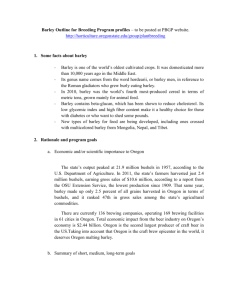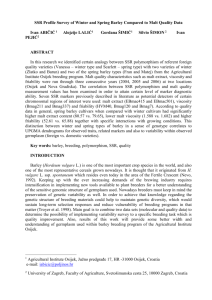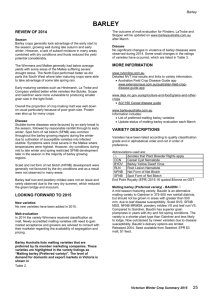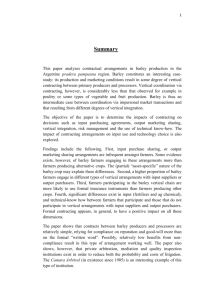World`s oldest crop
advertisement
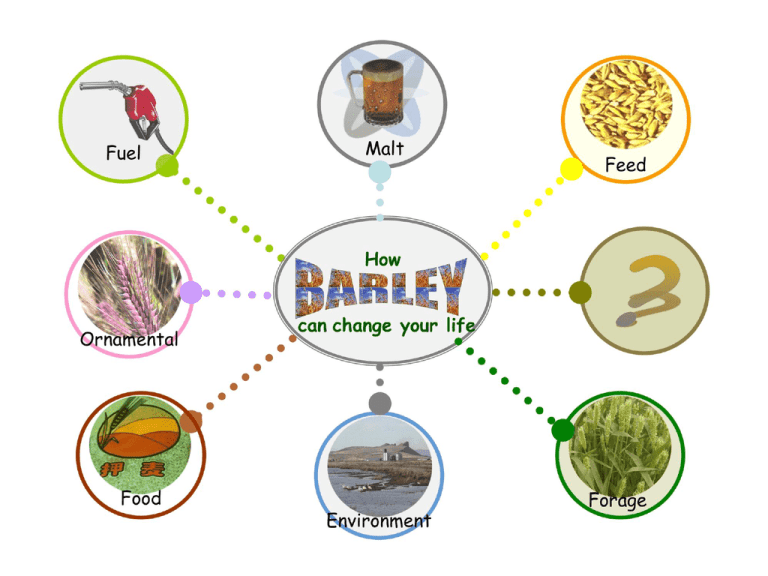
The ancestral state World’s oldest crop Native to Middle East Ancestral form is •winter habit •2-row •hulled 2-row vs. 6-row 1 gene/30,000 genes Winter vs. Spring What is the difference between winter and spring barley, and what the *%^&(+ is a facultative barley? The three growth habit classes of barley are winter, facultative and spring. A winter barley is planted in late fall and is harvested the following summer. A spring barley is planted in the spring and harvested the same summer. If you plant a winter barley in spring, it will not flower, or it will flower too late. If you plant a spring barley in the fall, it will (in many temperate environments) die from low temperature injury. A facultative barley can be planted in the spring or the fall, and it is cold-tolerant. There are three principal physiological traits involved: vernalization sensitivity, photoperiod sensitivity, and low temperature tolerance. Vernalization sensitivity means the plant needs exposure to low temperature before it can flower. Winter barleys are vernalization-sensitive whereas facultative and spring types are not. Photoperiod sensitivity means the plant will not flower until the day length reaches a critical threshold. Many winter barleys, most facultative barleys, and few spring barleys are sensitive to short days. Low temperature tolerance is an induced trait. Winter and facultative barleys are more cold tolerant than spring barleys. Since the traits are controlled by different genes our bets are on photoperiod-sensitive, cold-tolerant facultative varieties. http://barleyworld.org/FAQ_sheet.php Hulled vs. Hull-less The headache of pearls Malt vs. Feed Why some varieties are better for making beer than others •Barley malt is the perfect combination of starch, enzymes, Malt Feed Forage flavors, and aromas for brewing, distilling, baked goods, cereals and confections. There are many types of barley malt – from light to dark – but all are variations on two principal themes: germination and kilning. Different end-uses require different malt quality specifications. Some of the principal characteristics used to define malting quality are protein (low, moderate, or high), malt extract (high), enzyme activity (moderate to high), and beta glucan (low). •Feed barley is used as food for animals. Varieties also differ in their feeding properties but unfortunately feed barley is simply sold by the ton. Feed barley prices are often so low that farmers grow other crops - if they can do so. As a consequence, barley’s adaptability to extreme climates makes it an important feed grain only in areas where it is unprofitable to grow (or import) maize. •Hooded barley is a unique type of feed barley that has hoods, rather than awns. These types are usually cut green for hay or silage. The lack of awns allows for easy chewing by the animals. A rule of thumb is that good malt barley is good feed barley, but not the reverse. In general, malt barley commands a premium over feed barley, but yield less. Many genes determine malting and feed quality; two genes determine the hooded trait. http://barleyworld.org/FAQ_sheet.php Malting barley variety development Grain to Glass 11 – 13 years Time frame (yrs) Activity 2-3 Breeding and selection; initial agronomic assessment •Segregating generations •Doubled haploid populations 3-4 Preliminary to advanced agronomic testing and micro-malting of samples from multiple environments Amount of seed required for Amounts of seed available and scale one malting quality assessment 0 0g – 1 kg for breeding program 200 grams 1 kg – 20 kg for breeding and extension programs 20 kg –100 kg for 3 AMBA Pilot Scale Test must be rated satisfactory in 2/3 years of testing 7 kilograms/ location 2 locations AMBA Plant Scale malting and brewing trials 3 must be rated satisfactory in 3/3 brewing trials 800 metric tons breeding and extension programs. Initiate largescale increase of pure seed for commercial scale quality assessment and variety release Large volumes for onfarm testing and commercial scale malting and brewing Measure the traits that matter Molecular breedin Measure meaningful genetic diversity Why Barley? •Diversify •New products •Rotation •Whole grains in a complete diet •Full spectrum local supply •We have very productive areas for growing barley Raising barley – from seed to seed • Variety choice • Planting • Management • Harvest • Storage • End uses Varieties •Self-pollinated •Breed true •Variation due to limited crosspollination, mixture, mutation, breeding method •Growth habit •Winter, spring, facultative •Seed source •Certified, farmer-farmer, saved •Ownership •Public, PVP, licensed, patented Planting •How •Broadcast, drill •Seedbed preparation •Tillage, minimum-tillage, no-tillage •Seeding rate •Lbs/acre; seeds/square foot •Seeding date •Growth habit •Don’t spring-plant a winter •Diseases •Barley Yellow Dwarf Virus is a problem in early-seeded winters Management and who to contact at OSU Mike Flowers (CSS Extension) Weeds: Andrew Hulting (CSS Extension) • Companion Crops • Herbicides • Tillage • Mulches Diseases: Chris Mundt (BPP) •Yield and quality loss •Stripe rust •Contamination •Smut •Health hazards •Ergot •Fusarium Head Blight •Genetic resistance •Fungicides Insects: Sujaya Rao (CSS) •Cereal Leaf Beetle Nutrition:John Hart, Dan Sullivan (CSS) •N,P, K, +, +,+ Harvest Combine • Plot • Small • Standard Cutting •Hand tools •Mowers •Binders Threshing •Abrasion •Mechanical threshers Cleaning •De-hulling •Removing chaff •Removing other seeds Storage •Moisture •Insects •Rodents •Fungi Marketing Protein, seed weight/size (test weight, plump/thin) • • • • Malt (extract, enzymes), Food (beta glucan), Feed (protein, test weight), Forage (protein, fiber) Bringing it all home to Oregon Maja. Hyslop Farm. Lewisburg, OR 2010 Growth habit, end-use and disease resistance are key considerations for making management decisions and income projections Maja. Hyslop Farm. Lewisburg, OR 2010 Growth habit: winter, facultative, and spring Highest yields with winter or facultative barley Seeded mid-October and harvested in early July At least 6,000 lbs per acre and test weights > 50 lbs./bu Winter breeding nursery. CBARC. Pendleton, OR 2009 Late spring (March/April) plantings of barley will likely yield less than fall plantings and will require irrigation to achieve maximum yield Spring breeding nursery. Hyslop Farm, Lewisburg, OR 2010 Facultative varieties: plant any time Late winter/early spring (~ February) seeding of winter, facultative, or spring varieties is an option for some growers Spring breeding nursery (foreground) and winter breeding nursery (background). Hyslop Farm. Lewisburg, OR 2010 Principal end-uses are feed, food, forage, and malt Rogue ale hour. OR 2010 Malting varieties must meet specific quality criteria for malting and brewing The maltster and brewer will specify which variety (ies) will be contracted Feeders will typically specify test-weight The food barley market is developing The driver is Beta glucan = soluble dietary fiber Key differentiators are hulled vs. naked waxy vs. normal starch The hull is removed by genetics, de-hulling, pearling, or milling Forage varieties are hooded – no awns Harvested for hay, green chop, silage Grazed Grain The barley form of stripe rust can be very severe in the Willamette Valley: complete crop loss Scald: a matter of degree BYDV can be a problem in early fall plantings Stripe rust on susceptible varieties. Hyslop Farm. Lewisburg, OR Any year Choose adapted varieties Barleyworld.org 541-737-5878 Patrick.m.hayes@oregonstate.edu Variety recommendations Winter Feed – Strider, Alba (2012) Food – Streaker (2012), WinCrisp (2013) Forage – Verdant (2011) Malting – Endeavor (2-row), Maja (6-row; facultative) Spring 2-row


